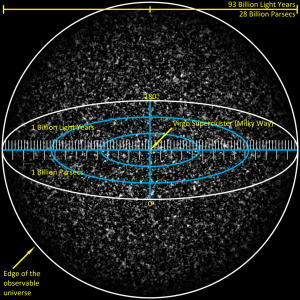 There continues to be much debate among scientists about the cosmological principle. Is the universe infinite or is it finite but unbounded? Of course, in either case we must presume that the universe is in fact, isotropic which, in itself is somewhat of a conundrum given the nature of special relativity, comoving distances and Olbers’ paradox.
There continues to be much debate among scientists about the cosmological principle. Is the universe infinite or is it finite but unbounded? Of course, in either case we must presume that the universe is in fact, isotropic which, in itself is somewhat of a conundrum given the nature of special relativity, comoving distances and Olbers’ paradox.
Since you may require some background information to understand where I am going with this I will link all appropriate words to their definitions, primarily found on Wikipedia. And of course if you have any specific questions or contributions, please comment!
I am going to make some pretty big leaps here I hope I don’t lose anyone on the way. First, it is important to understand some of the common misconceptions regarding the differences between: the universe and the observable universe.
The following are some of the wide array of inaccurate figures for the size of the visible universe:
13.7 billion light-years: The age of the universe is estimated to be 13.7 billion years. Because it is generally understood that nothing can accelerate to velocities greater than or equal to that of light, it is a common misconception that the observable universe’s radius must then 13.7 billion light-years. This would only make sense if the universe is the flat spacetime of special relativity; in the real universe, spacetime is very curved on cosmological scales. This means that 3-space is expanding, as described in Hubble’s law. Distances obtained as the speed of light multiplied by a cosmological time interval have no direct physical significance.
15.8 billion light-years: This is calculated similarly to the 13.7 billion light year figure, but is based on an incorrect age of the universe as published in the popular press in mid 2006.
27.4 billion light-years: This is a diameter derived from the incorrect radius of 13.7 billion light-years.
78 billion light-years, 156 billion, and 180 billion: are all based on misconceptions relating to the postulation that the entire universe is, in fact, finite and unbounded.
The comoving distance from earth to the edge of the observable universe is about 14 billion parsecs or 4,600,000,000,000 light years in any direction. Thus, the observable universe is a sphere with a diameter of about 28 billion parsecs or 9,300,000,000,000 light years. Assuming that space is roughly flat, this size corresponds to a comoving volume of about 3,000,000,000,000,000,000,000,000,000,000,000,000,000,000,000,000,000,000, 000,000,000,000,000,000,000,000,000 cubic meters. This is equivalent to a volume of about 41 decillion (41,000,000,000,000,000,000,000,000,000,000,000 cubic light-years).
Therefore, if the universe the universe is 13.7 billion years old and yet the distance to the edge of the observable universe is 41 billion light-years, the rate of expansion of the universe is not constant. As the universe expands it is shown to expand at an ever growing exponential rate. Thus some of the universe is expanding away from another part of the universe at faster than the speed of light and this rate of expansion is ever increasing.
Unless some other future change is introduced the universe can be correctly stated to be infinite wether or not it actually is infinite now because it tends to be infinite and its bounds can never be reached or defined since one cannot accelerate to the speed of light.
So what happens when the rate of acceleration of expansion becomes infinite and all distances in the universe diverge to infiniti? I’ll offer a new theory in my next cc article!
